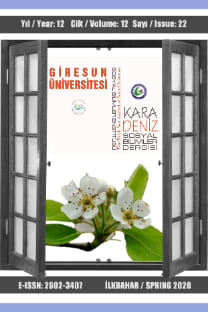Alıştırmalardan Etkinliklere: Eğitimdeki Gelişmeler
Eğitim, Alıştırma, Etkinlik, Ders kitabı
From Exercises to Activities: Educational Developments
Education, Exercise, Activity, Lesson books,
___
- Avram,C.(2006). Les Exercices Structuraux, les techniques, techniques,dialogos, www.romanice.ase.ro/dialogos/.../09_Avram-Les-exercices.... adresinden erişilmiştir.
- Barnier,G.(2005).L’approche socio-constructive des apprentissages scolaires, Psychologie de l’éducation, Thème 2, IUFM d’aix-Marseille.
- Basque, J. (1999). L’İnfluence du Béhaviorisme, du Cognitivisme et du Constructivisme sur le Design Pédagogique, Actes du XIIe Colloque du CIPTE, Montréal.
- Bertocchini,P. ve Costanzo,E. (2014).La Notion d'exercice, Le Français Dans le Monde, 12.12.2016 tarihinde www.fdlm.org adresinden erişilmiştir.
- Besse,H. ve Porquier,R.(1984). Grammaire et didactique des langues, Hatier-Credif.
- CECR (2000). Cadre européen commun de référence pour les langues. Apprendre, enseigner, évaluer, Division Des Langues Vıvantes, Strasbourg: Conseil de l’Europe, Didier.
- Cedlova,M. (2013).Tâches et activités : au service de l'enseignement-apprentissage en FLE, Západočeská univerzita v Plzni Fakulta filozofická Plzeň https://otik.uk.zcu.cz/.../Taches%20et%20activites%20%20a...adresinden erişilmiştir.
- Conejo López-Lago,E. (2006). Qu’est-ce qu’une tâche ?,Rahmen des Projektes “Español Online” adapté en français par Philippe Liria, 10.11.2016 tarihinde http://www. difusion.com/uploads/2004/Ideas/Recursos/1246.pdf adresinden erişilmiştir.
- Contamines,J.(2013). Guide de conception d’un scénario d’apprentissage,(INF 9013 Les TIC et l’apprentissage en milieu de travail), 23.01.2017 tarihinde http://www benhur.teluq.uquebec.ca/.../inf9013/.../GuideConceptionSce... adresinden erişilmiştir.
- Cuq,J.P, ve Gruca,İ.(2005). Cours dè didactique du français langue étrangère et seconde, Paris:PUG.
- Çevik, A. ve Güneş, F. (2017). Türkçe ders kitaplarındaki etkinliklerin incelenmesi, Ana Dili Eğitimi Dergisi, 5(2), 272-286
- Deschênes, A.-J., Bourdages, L., Michaud, B., et Lebel, C. (1992). Les activités d’apprentissage dans des cours conçus pour l’enseignement à distance, Journal of Distance Education, VII(1), 53-81.
- Deschênes, A.-J. (1995). Vers un modèle constructiviste de la production des textes in J.-Y Boyer, J.-P. Dionne et P. Raymond (dir.). La production de texte ,Montréal: Les éditions Logiques.
- Deschênes, A.-J., Bilodeau, H., Bourdages, L., Dionne, M., Gagné, P., Lebel, C., ve Rada-
- Donath, A. (1996). Constructivisme et formation à distance. Distances. 1(1), 9-25.
- Dessaint, M.-P. (1995). Au coeur de l’apprentissage: les objectifs et les activités. In M.-P.
- Dessaint (Ed.), La conception de cours: Guide de planification et de rédaction, Sainte-Foy ,Canada : Presses de l’Université du Québec.
- DİSCAS.(2005). L'activité d'apprentissagei Les archives de DISCAS, 02.01.2006 tarihinde www.csrdn.qc.ca/discas/Apprentissage/activiteApprentissage adresinden erişilmiştir.
- Güneş,F. (2014).Sınıf yönetimi,yaklaşım ve modeller, Ankara :Pegem A Yayınları.
- Güneş, F.(2015). Türkçe öğretimi yaklaşımlar ve modeller, Ankara:Pegem A Yayınları.
- Güneş, F.(2017,a). Türkçe öğretiminde etkinlik yaklaşımı, Ana Dili Eğitimi Dergisi, Journal Of Mother Tongue Education ADED-JOMTE, 5 (1): 48-64
- Güneş, F.(2017,b). Okuma ve anlama etkinliklerinde nitelik sorunu, I. Uluslararası Sınırsız Eğitim ve Araştırma Sempozyumu (USEAS2017) Tam Metin Bildiri Kitabı, SEAD,24- 26 Nisan 2017 Alanya/Antalya E-ISBN 978-605-82661-1-7
- Labédie, G. ve Amossé, G.(2001). Constructivisme ou socio-constructivisme?. Pädagogisches Institut der deutschen Sprachgruppe, Bozen DDEC de Nantes.
- Landry, F. (1986). Revue de littérature sur le rôle des activités d’apprentissage dans l’enseignement à distance. Sainte-Foy, QC : Télé-Université.
- Malenfant, N. (2002). Routines et transitions en services éducatifs. Québec : Presse de l’Université Laval.
- MEB.Talim ve Terbiye Kurulu Başkanlığı (2005). İlköğretim Türkçe Dersi Öğretim Programı ve Kılavuzu, Ankara: MEB Basımevi.
- Oddou,M.(2017). Théories de l’apprentissage et activités fle, 06.06.2017 tarihinde www.moddou.com/.../theorie-activites-FLE-Marc-Oddou-B... adresinden erişilmiştir.
- Pollet, D.(2015). Elève : acteur actif de son apprentissage : le triple a gagnant ? Analyse n°15 FAPEO, Décembre 2015, www.fapeo.be/analyses adresinden erişilmiştir.
- Pourtois, J-P., Desmet, H.(2002). L’éducation postmoderne, 3ème Edition,Paris: PUF.
- Vigner, G.(1984).L’Exercice dans la classe de français, Paris:Edition Hachette .
- ISSN: 2602-3407
- Yayın Aralığı: 2
- Başlangıç: 2009
- Yayıncı: -
İyi Tarım Uygulamaları: Migros Ticaret Anonim Şirketi Örneği
Öğretmenlerin Özerklik Davranışları İle İş Doyumları Arasındaki İlişki
İbrahim ÇOLAK, YAHYA ALTINKURT, Kürşad YILMAZ
İslamlaşma Sürecinden Cumhuriyete Giresun’da Eğitim- Öğretim
GÜLHAN GÜVEN, VEDAT BAYRAKTAR, ZEYNEP FULYA TEMEL
Sözlü Kültür Ortamında Derlenen Mukaddem Ali Destanındaki Tarihî Gerçeklik
Alıştırmalardan Etkinliklere: Eğitimdeki Gelişmeler
Hikmetlerin Dilinden Hoca Ahmed Yesevî
İlköğretim Öğrencilerinde Proje Tabanlı Mikroskobik Canlı Bilincinin Oluşturulması
SERPİL UĞRAŞ, HASAN KAĞAN KESKİN, NİSA SİPAHİ, Hacer DURSUN
Bir Türk Subayının Raporuna Göre Mübadelenin Yunanistan’daki Yansımaları
